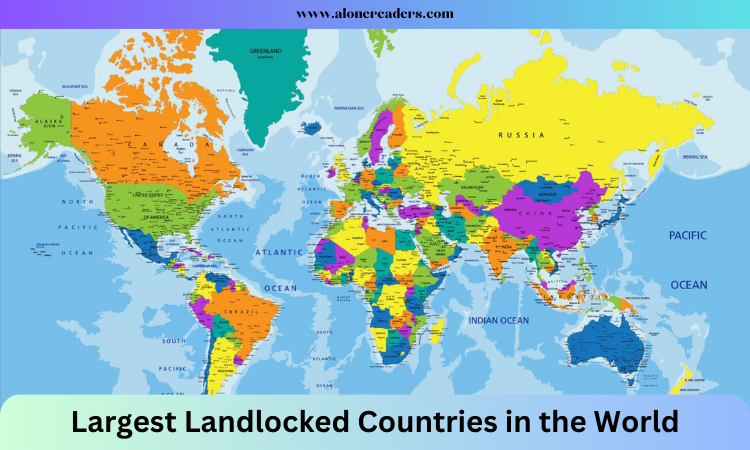
There are approximately 200 different countries in the world, and the majority of them have access to the oceans. Long before airplanes were developed, this was helping in the development of their economies through international trade.
However, around one-fifth of the world's countries are landlocked, which means they lack any physical access to the ocean. Despite this, many of these nations have managed to trade, conquer, and expand their borders without the use of seaports.
A country is considered to be landlocked if its territory is not connected to an ocean or if its coastlines are on endorheic basins. There are now 44 landlocked countries and 4 de facto landlocked states. Kazakhstan is the largest landlocked country in the world, whereas Ethiopia is the country with the greatest number of landlocked people.
Below are the 10 largest landlocked countries in terms of prosperity, population, and land mass:
Kazakhstan
With an area of 2,724,900 km², Kazakhstan is the largest landlocked country and the ninth largest country in the world. Kazakhstan is a country in Central Asia that shares borders with Kyrgyzstan, China, Turkmenistan, Russia, and Uzbekistan. The population of the nation is 18,513,930. Kazakhstan, whose capital is Astana, has been an independent country since 1991.
Mongolia
With a total area of 1,564,116 km2, Mongolia is the second-largest landlocked country on the entire planet. Mongolia is a country in northern Asia that borders both China and Russia. The population of the country is 3,225,170 and Ulaanbaatar is the capital of it.
Chad
With a geographic area of 1,284,000 km², Chad is the largest of Africa's 16 landlocked countries. Its population is 15,946,880. The nation shares borders with Cameroon, the Central African Republic, Libya, Niger, Nigeria, and Sudan. Chad's capital city is N'Djamena. Since its independence in 1960, Chad has had a democratically elected government.
Niger
Niger, which borders Chad on the west, has a land area of 1,267,000 km² and a population of 23,310,720. Seven West African nations surround Niger, including Algeria, Benin, Burkina Faso, Chad, Libya, Mali, and Nigeria. The capital of Niger is Niamey, which became independent from France in 1960, and is also one of the biggest cities in Western Africa.
Mali
With a land area of 1,240,192 km², Mali is the fifth-largest landlocked country in the world. The nation is situated in West Africa and shares borders with seven other nations, including Burkina Faso, Algeria, Guinea, Cote d'Ivoire, and Niger. There are 19,658,030 people living in the nation. Mali's capital city is Bamako. The Mali Federation was established in January 1959 when Soudan and Senegal joined up. However, the federation collapsed after just one year, enabling Soudan to declare itself the Republic of Mali in September 1960. Presidential elections with multiple parties are now held in Mali.
Ethiopia
With a landlocked area of 1,104,300 km² and a population of 112,078,730, Ethiopia is located in Eastern Africa. The country is the sixth biggest landlocked country in the world and shares a border with six other nations including Sudan, Kenya, Eritrea, Djibouti, South Sudan, and Somalia. Ethiopia has been independent since May of 1941 and has a longer history than many other African countries. Its capital is Addis Ababa.
Bolivia
Bolivia is a country in South America with a land area of 1,098,581 km² and a population of 11,513,100. Bolivia, which is regarded as a unitary presidential constitutional republic, has its capital in La Paz. Bolivia is a country in central South America that has borders with five other nations including Peru, Paraguay, Chile, Brazil, and Argentina.
Zambia
With an area of 752,618 km², Zambia is a landlocked country in southern Africa that borders eight other nations, including Zimbabwe, Angola, Botswana, Namibia, Tanzania, Mozambique, and Malawi. The total population of the nation is 17,861,030. In 1964, the Republic of Zambia was formed.
Afghanistan
Afghanistan is a landlocked country in South Asia with a population of 38,041,750 and a land area of 652,230 km². Afghanistan shares borders with six nations including Pakistan, Tajikistan, Turkmenistan, Uzbekistan, China, and Iran.
South Sudan
The 10th largest landlocked country in the world is South Sudan, which has an area of 644,329 km². South Sudan is a country in East Central Africa that has borders with Ethiopia, Sudan, Kenya, Uganda, and the Democratic Republic of the Congo. The estimated number of its population is 11,062,110.
Final World
Landlocked countries have a variety of benefits and drawbacks. These nations may regulate products entering or leaving the country through the borders and are reasonably well protected from bad weather induced by oceans, such as hurricanes and tsunamis. Landlocked nations are shielded against maritime incursions. These nations, particularly the developing ones, face difficulties in the import and export of goods, which forces them to rely on their friendly neighbors. The expense of transportation and customs fees increases for landlocked countries. Landlocked countries must keep friendly relations with coastal nations even when they disagree in order to access the coastline.